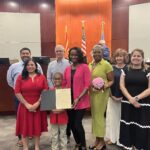We’ve been discussing boundaries and bridges lately. Why? They’re important; they matter. So, to continue with the topic of boundaries, boundary spanning, boundary riding, and being a bridge, what would some of these boundaries look like? What do they look like when put into action? Here are a few to think about.
First, we’ll look at horizontal boundaries. This type of spanning involves functions of the organization, such as expertise, departments, and disciplines.
Developing cross-functional collaboration is a growing need in many organizations due to the erected walls that have been established within the organizational culture for decades. “That’s accounting over there, but we are operations. We don’t work with them.”
Silo-busting is now a focus for leaders and managers in order to facilitate lateral cross-functional teamwork.
Next, let’s look at vertical boundaries. When we speak about ‘culturally flat’ organizations, we are referring to organizations that have successfully dealt with vertical boundary spanning. This type of spanning is between hierarchical groups of the organization, including rank, class, seniority, authority, and power.
This type of spanning increases perspective-taking and rests upon the development of the 7 gems (more in-depth information can be found in the 7 Gems of Intercultural Creativity®).
Lastly, let’s quickly discuss stakeholder boundaries. As we blur the lines within our organization, we need to blur the lines externally as well. This type of spanning involves those outside groups of customers, partners and constituencies, and community members.
How organizations connect, communicate, and create—not only for these groups but with these groups—depends on their level of intercultural creativity.
By incorporating Intercultural Creativity®, this will not only change the landscape of leadership but also bring authentic humanity back into our work and or lives.
Being a boundary spanner is very important.
What are some characteristics that would be characterized as boundary spanning? How about within demographic or geographic boundaries? We can’t forget about these two important boundaries.
Maybe we could start by identifying our similarities and then gradually incorporate those differences, if they add value and will build the people around us.
Being a bridge and knowing how to connect and span across boundaries is a vital interculturally creative skill. Leaders who develop the transferable skills of the 7 gems will be equipped to authentically adapt to and span across various cultural boundaries.





